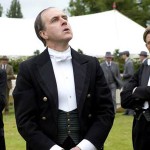For Americans, the Fourth of July means many things: American history, national pride, family cookouts, brilliant fireworks, and — for nerds like me — an all-day marathon of The Twilight Zone on the SyFy Channel. Rod Serling’s 1960s anthology series has, for many years, been a favorite of mine, though it did not start out that way. As a kid, I knew The Twilight Zone by reputation only. It was that weird black-and-white horror or science fiction show, and there always seemed to be something menacing about it. Didn’t it have magic or devils in it? Wasn’t it pessimistic, dark, or just plain evil?
These misgivings were allayed when, as a teenager, I picked up a copy of Marc Scott Zicree’s The Twilight Zone Companion at my local library. Looking through the summaries of the episodes and Zicree’s commentaries on them, I realized that even though the series played on tropes familiar to the genres of science fiction, fantasy, and horror, it was animated by a profound sense of humanity. Indeed, at its core, The Twilight Zone was a quiet, thoughtful series of meditations on the significance of humanity in the face of the challenges of modern life, following relatable characters as they experienced life’s triumphs and tragedies.
The first of The Twilight Zone’s five seasons aired in 1959. The series was the brainchild of Rod Serling, a writer with several years of television experience to his credit. Every episode featured some element of science fiction or the supernatural, and while some actors appeared in several episodes, each one was a self-contained story. The shows were only half an hour long, with the exception of the ill-fated fourth season, when CBS attempted (with limited creative success) to convert the series to an hour-long format. Most of the episodes famously began and ended with brief monologues delivered on-camera by Serling himself. After its initial run, The Twilight Zone was resurrected for three seasons in the late 1980s and again for a single season in the early 2000s.
Despite The Twilight Zone’s supernatural trappings, its heart was more often than not in the people it depicted, characters who were memorably portrayed by some of the era’s best actors. Serling — a WWII veteran and onetime English major with a background in radio drama — had a near flawless ear for intelligent, sensitive dialogue as well as an intense work ethic. (He wrote well over half of the show’s more than 150 episodes.) Other similar shows of the era, such as ABC’s The Outer Limits, elevated the genre element over the heart. Thus, while the special effects or ideas may seem dated half a century later, The Twilight Zone endures in popularity because it was never fundamentally about the external flash.
Indeed, far from being the evil drama that I, in my youth, had imagined it to be, The Twilight Zone staked out a moral territory that was often religious, and occasionally explicitly Christian. While some episodes were comedies in the modern sense, I was surprised to discover that even more were comic in the classical sense, ending with resolution and restoration. In “The Changing of the Guard,” an aging teacher comes to learn that his life has been well-lived. “Kick the Can” sees residents of a nursing home renewed by returning to childhood pursuits. “Two” is a surprisingly touching romance between former enemies, the last survivors of an apocalyptic war. And in “The Night of the Meek,” Honeymooners star Art Carney plays a destitute drunk transformed into a genuine Santa Claus.
Of course, not every episode ended happily ever after. The Twilight Zone became renowned for its twist endings, often at the protagonists’ expense. Yet Serling’s world was never sadistic, inflicting pain on characters purely as some cruel thought experiment. When a sympathetic individual was ill-served, the show’s writers made sure the audience would feel the impact. What viewer of the classic “Time Enough at Last” can keep from wincing at the fate of Burgess Meredith’s character, even if we believe that he has been justly served for his escapism?
Serling was especially effective at using such devastating reversals in his critique of totalitarian dystopias. “The Eye of the Beholder” is a justly celebrated and innovative meditation on beauty, one which occurs in a despotic setting. Less well-known but equally chilling is “Number 12 Looks Just like You,” which explores the same theme from a different angle but again in a bleak future. And who could forget “The Obsolete Man,” in which Burgess Meredith powerfully reads Scripture while locked in a room with his state-appointed executioner?
Paired with Serling’s representation of human dignity, in joy and suffering, was an equally palpable recognition of human depravity. And if the moral universe of The Twilight Zone sometimes acknowledged the unjust suffering of sympathetic people, it seldom allowed the more profoundly wicked to escape unscathed. “Deaths-Head Revisited” depicts a former Nazi officer forced to confront the ghosts of those he killed. Seemingly ordinary townspeople are driven to paranoia against one another in “The Monsters Are Due on Maple Street.” And in a parable about the importance of faith, survivors of a nuclear war are killed by their own skepticism in “The Old Man in the Cave.”
It takes less than half an hour to watch a full episode of The Twilight Zone. Yet its most powerful episodes can haunt viewers in the best way for years. The show’s special effects or alien makeup may look indescribably silly by contemporary standards, and some of its prognostications are obviously a product of its era. But its pristine, thoughtful dialogue; its subtle, innovative direction; its engaging, heart-rending acting; and its philosophical, moral gravity all remain as powerful today as they were half a century ago.










